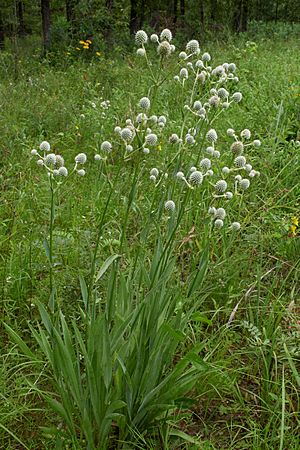Eryngium yuccifolium facts for kids
Quick facts for kids Eryngium yuccifolium |
|
|---|---|
 |
|
| Scientific classification | |
| Genus: |
Eryngium
|
| Species: |
yuccifolium
|
| Synonyms | |
|
Eryngium synchaetum J.M.Coult. & Rose |
|

Eryngium yuccifolium, also known as rattlesnake master, is a special plant. It's a perennial herb, meaning it lives for more than two years. This plant belongs to the parsley family. You can find it growing naturally in the tallgrass prairies of central and eastern North America. It grows from Minnesota all the way east to Ohio. It also grows south to Texas and Florida. You can even spot it in a few places like Connecticut, New Jersey, Maryland, and Delaware.
Contents
What's in a Name?
The common name "rattlesnake master" is quite interesting. It comes from the fact that some Native Americans used the plant's root. They believed it could be an antidote for rattlesnake venom. The scientific name yuccifolium means "yucca-leaved." This name was given because its leaves look a lot like those of yucca plants.
What Does it Look Like?
The rattlesnake master plant has stiff, long, and narrow leaves. They have a sharp tip and can be from 15 to 100 centimeters (about 6 to 39 inches) long. But they are only about 1 to 3 centimeters (0.4 to 1.2 inches) wide. The leaves are a cool bluish-green color. They also have a waxy coating that helps protect them. Along the edges of the leaves, you'll find bristles or small spines.
The plant's root system is strong. It has a main taproot that goes deep into the ground. Around this taproot are many thick, fleshy roots.
How Tall Does it Grow?
This plant can grow quite tall, up to 1.8 meters (about 6 feet) high. At the top of each stem, it produces many dense, ball-shaped flower clusters. There can be anywhere from 10 to 40 of these clusters.
About its Flowers
Each of these ball-shaped flower clusters is about 1 to 3 centimeters (0.4 to 1.2 inches) across. They look a bit like single flowerheads. The individual flowers inside these clusters are small, only 3 to 4 millimeters (about 0.1 to 0.2 inches) wide. They have greenish-white or bluish-white petals. They also have a light, sweet smell, like honey.
Underneath each tiny flower, there's a spiny green leaf-like part called a bract. And under each whole flower cluster, there's a small star-shaped group of spiny bracts. The flowers usually bloom in July and August.
How it Makes Seeds
When the flower buds open, the pollen is ready first. It's released two to three days before the female parts of the flower (the stigmas) are ready to receive it. This is a clever way to encourage cross-pollination. It makes it less likely that a flower will fertilize itself. Rattlesnake master is very good at making seeds, with almost 90% of its flowers producing them.
Where Does it Grow?
In natural areas that haven't been disturbed, Eryngium yuccifolium doesn't like changes made by people. However, it grows easily when planted in areas where prairies are being restored.
Who Visits the Flowers?
The flowers of rattlesnake master attract many different insects. These include short-tongued and long-tongued bees, flies, beetles, and butterflies. But the most common visitors are wasps. This plant is also a special host for the larvae (young) of the rattlesnake-master borer moth (Papaipema eryngii). This means the moth's caterpillars eat the plant.
How to Grow it in a Garden
Many plant nurseries that sell native plants offer rattlesnake master. People buy it for restoring prairies or creating native meadows. It's also popular for gardens and landscapes.
Growing Conditions
This plant grows best in full sun. It also needs soil that drains water well. The soil should be slightly acidic to slightly alkaline. It can get root rot if the soil stays too wet for too long.
Once you plant it, it's best to leave it alone. Don't dig it up and replant it like you might with some other perennial plants. This is because it develops a large taproot and other thick, fleshy roots that don't like to be disturbed. In gardens, it often drops its own seeds and new plants grow on their own.
Past Uses
The strong fibers from the rattlesnake master plant were used a long time ago. Ancient Native Americans in the Midwest used these fibers. They were one of the main materials for making shoes.
See also
 In Spanish: Eryngium yuccifolium para niños
In Spanish: Eryngium yuccifolium para niños

